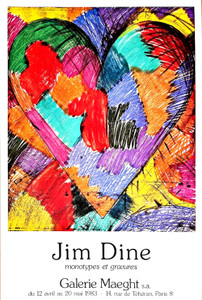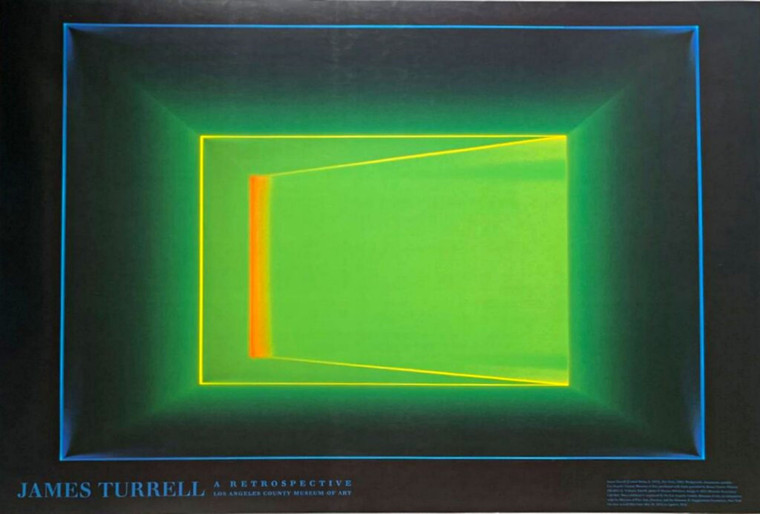
James Turrell
Key Lime, Rare LACMA Exhibition print, 2013
Offset lithograph
Unsigned
Unnumbered
24 × 36 inches
Unframed
“Light is not so much something that reveals, as it is itself the revelation.”
James Turrell
Rare offset lithograph poster
Published on the occasion of the exhibition James Turrell: A Retrospective, at the Los Angeles Museum of Art (LACMA), in conjunction with the Museum of Modern Art, Houston, Texas and the Solomon R. Guggenheim Foundation, New York.
The work depicted in this poster is the widely reviewed and reproduced:
James Turrell, “Key Lime” (1994), wedgework: flourescent and LED light into space with fiber-optic light, dimensions vairable. Collection of LACMA.
Limited Edition: exact number published unknown
Unframed; unsigned
JAMES TURRELL BIOGRAPHY
James Turrell has dedicated his practice to what he has deemed perceptual art, investigating the materiality of light.
Influenced by the notion of pure feeling in pictorial art, Turrell’s earliest work focused on the dialectic between constructing light and painting with light, building on the sensorial experience of space, color, and perception. These interactions became the foundation for Turrell’s oeuvre. Since his earliest Projection Pieces (1966–69), his exploration has expanded through various series, including Skyspaces (1974–), Ganzfelds (1976–), and perhaps most notably, his Roden Crater Project (1977–) near Flagstaff, Arizona.
Applying through an advertisement in the back of Artforum Turrell entered graduate school in the fall of 1965 at the newly established University of California at Irvine, where he studied under artists Tony DeLap, John McCracken, and David Gray as well as with art historians John Coplans and Walter Hopps. During this time, Turrell produced some of his first light sculptures, using gases to create flat flames that burned in even colors. These early works proved challenging to control, halting further experimentation in the medium.
In 1966 Turrell rented a studio space in the former Mendota Hotel in Ocean Park, California, where he began to work with high-intensity projectors as a light source, producing the first of his Projection Pieces, Afrum-Proto, in the spring of 1966. Shortly thereafter, Turrell decided to focus exclusively on his practice and abandoned his graduate studies. From the end of 1968 to 1969 he participated in the Art and Technology program at the Los Angeles County Museum of Art, which brought contemporary artists together with engineers. Alongside fellow artist Robert Irwin and psychologist Dr. Edward Wortz, Turrell studied the optical phenomenon known as the Ganzfeld effect—the loss of perceptive fields through sensory deprivation. These studies of perceptual anomalies further ignited his interest in the celestial realm, and he began to incorporate aviation into his practice by creating sky drawings with the artist Sam Francis.
Turrell’s first one-person exhibition, James Turrell: Light Projections, was held in the fall of 1967 at the Pasadena Art Museum. Curated by John Coplans, an accompanying catalogue essay was also published in the October 1967 issue of Artforum. This seminal exhibition positioned Turrell at the forefront of the Light and Space movement.
The artist set out to create architectural sites in which the sun and the moon are brought into intimate spaces, theatres similar to his Autonomous Structures made of concrete and stone. In addition to twenty-two permanent installations at institutions such as the Henry Art Gallery, Seattle; Fine Arts Museums of San Francisco, de Young Museum; and P.S. 1, Long Island City, New York, Turrell has worked on his (opens in a new window)Roden Crater Project (1977–), a large-scale work in a volcanic cinder cone in the Painted Desert region of northern Arizona. Situated in the basin of a 400,000-year-old extinct volcano the Roden Crater Project was initiated after Turrell received a Guggenheim Fellowship award in 1974, which coincided with the loss of his Santa Monica studio. He immediately set out to find a site framed in a geologic stage of time at an altitude that would “increase a sense of close-in celestial vaulting from the bottom of the crater.”
Turrell’s practice has equally materialized in small-scale works, including architectural models, holograms, and works on paper.
-Courtesy PACE Gallery







